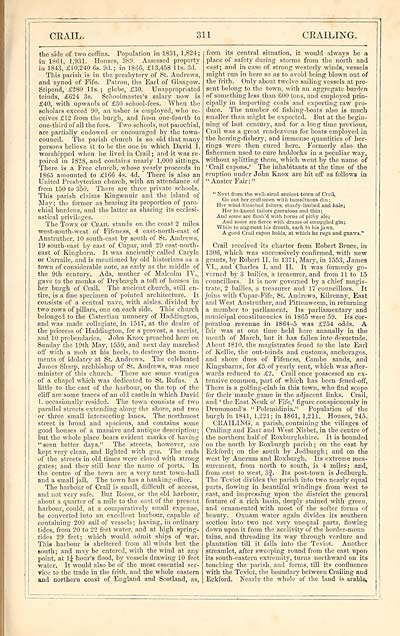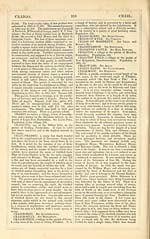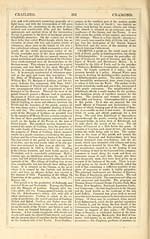Download files
Complete book:
Individual page:
Thumbnail gallery: Grid view | List view

CRAIL.
311
CRA1LING.
tho side of two coffins. Population in 1831, 1,824;
in 1861, 1,931. Houses, 380. Assessed property
in 1843, £10,240 6s. 9d.; in 186G, £13,458 lis. 3d.
This parish is in the presbytery of St. Andrews,
and synod of Fife. Patron, the Earl of Glasgow.
Stipend, £280 lis.; glebe, £30. Unappropriated
teinds, £624 3s. Schoolmaster's salary now is
£40, with upwards of £30 school-fees. When the
scholars exceed 90, an usher is employed, who re-
ceives £12 from the burgh, and from one-fourth to
one-third of all the fees. Two schools, not parochial,
are partially endowed or encouraged by the town-
council. The parish church is so old that many
persons believe it to be the one in which David I.
■worshipped when he lived in Crail ; and it was re-
paired in 1828, and contains nearly 1,000 sittings.
There is a Free church, whose yearly proceeds in
1865 amounted to £166 4s. 4d. There is also an
United Presbyterian church, with an attendance of
from 150 to 350. There are three private schools.
This parish chums Kingsmuir and the island of
May; the former as bearing its proportion of paro-
chial burdens, and the latter as sharing its ecclesi-
astical privileges.
The Town of Ckail stands on the coast 2 miles
west-south-west of Fifeness, 4 east-north-east of
Anstruther, 10 south-east by south of St. Andrews,
19 south-east by east of Cupar, and 29 east-north-
east of Kinghorn. It was anciently called Caryle
or Carraile, and is mentioned by old historians as a
town of considerable note, as early as the middle of
the 9th centuiy. Ada, mother of Malcolm IV.,
gave to the monks of Dryburgh a toft of houses in
her burgh of Crail. The ancient church, still en-
tire, is a fine specimen of pointed architecture. It
consists of a central nave, with aisles, divided by
two rows of pillars, one on each side. This church
belonged to the Cistertian nunnery of Haddington,
and was made collegiate, in 1517, at the desire of
the prioress of Haddington, for a provost, a sacrist,
and 10 prebendaries. John Knox preached here on
Sunday the 19th May, 1559, and next day marched
off with a mob at his heels, to destroy the monu-
ments of idolatry at St. Andrews. The celebrated
James Sharp, archbishop of St. Andrews, was once
minister of this church. There are some vestiges
of a chapel which was dedicated to St. Rufus. A
little to the east of the harbour, on the top of the
cliff are some traces of an old castle in which David
I . occasionally resided. The town consists of two
parallel streets extending along the shore, and two
or three small intersecting lanes. The northmost
street is broad and spacious, and contains some
good houses of a massive and antique description;
but the whole place bears evident marks of having
" seen better days." The streets, however, are
kept very clean, and lighted with gas. The ends
of the streets in old times were closed with strong
gates; and they still bear the name of ports. In
the centre of the town are a very neat town-hall
and a small jail. The town has a banking-office.
The harbour of Crail is small, difficult of access,
and not very safe. But Eoom, or the old harbour,
about a quarter of a mile to the east of the present
harbour, could, at a comparatively small expense,
be converted into an excellent harbour, capable of
containing 200 sail of vessels; having, in ordinary
tides, from 20 to 22 feet water, and at high spring-
tides 29 feet; which would admit ships of war.
This harbour is sheltered from all winds but the
south; and may be entered, with the wind at any
point, at lj hour's flood, by vessels drawing 10 feet
water. It would also be of the most essential ser-
vice to the trade in the frith, and the whole eastern
and northern coast of England and Scotland, as,
from its central situation, it would always be a
place of safety during storms from the north and
east; and in case of strong westerly winds, vessels
might run in here so as to avoid being blown out of
the frith. Only about twelve sailing vessels at pre-
sent belong to the town, with an aggregate burden
of something less than 600 tons, and employed prin-
cipally in importing coals and exporting raw pro-
duce. The number of fishing-boats also is much
smaller than might be expected. But at the begin-
ning of last century, and for a long time previous,
Crail was a great rendezvous for boats employed in
the herring-fishery, and immense quantities of her-
rings were then cured here. Formerly also the
fishermen used to cure haddocks in a peculiar way,
without splitting them, which went by the name of
' Crail capons.' The inhabitants at the time of the
eruption under John Knox are hit off as follows in
" Anster Fair:"
" Next from the well-aired ancient town of Crail,
Go out her craftsmen with tumultuous dill ;
Her wind-bleached fishers, sturdy-limbed and hale;
Her in-kneed tailors garrulous and thin ;
And some are flush'd with horns of pithy ale;
And some are fierce with drams of smuggled gin;
While to augment his drouth, each to his jaws,
A good Crail capon holds, at which he rugs and gnaws."
Crail received its charter from Robert Bruce, in
1306, which was successively confirmed, with new
grants, by Robert II. in 1371, Mary, in 1553, James
VI., and Charles I. and II. It was formerly go-
verned by 3 bailies, a treasurer, and from 11 to 15
councillors. It is now governed by a chief magis-
trate, 2 bailies, a treasurer and 17 councillors. It
joins with Cupar-Fife, St. Andrews, Kilrenny, East
and West Anstruther, and Pittenweem, in returning
a member to parliament. Its parliamentary and
municipal constituencies in 1865 were 59. Its cor-
poration revenue in 1864-5 was £254 odds. A
fair was at one time held here annually in the
month of March, but it has fallen into desuetude.
About 1810, the magistrates feued to the late Earl
of Kellie, the out-teinds and customs, anchorages,
and shore dues of Fifeness, Cambo sands, and
Kingsbarns, for £5 of yearly rent, which was after-
wards reduced to £2. Crail once possessed an ex-
tensive common, part of which has been feued-off,
There is a golfing-club in this town, who find scope
for their manly game in the adjacent links. Crail,
and ' the East Neuk o' Fife,' figure conspicuously in
Dmmmond's " Polemidinia." Population of the
burgh in 1841, 1,221; in 1861, 1,211. Houses, 245.
CRAILING-, a parish, containing the villages of
Crailing and East and West Nisbet, in the centre of
the northern half of Roxburghshire. It is bounded
on the north by Roxburgh parish ; on the east by
Eckford; on the south by Jedburgh; and on the
west by Ancrum and Roxburgh. Its extreme mea-
surement, from nortb to south, is 4 miles; and,
from east to west, 3§. Its post-town is Jedburgh-.
The Teviot divides the parish into two nearly equal
parts, flowing in beautiful windings from west to
east, and impressing upon the district the general
feature of a rich basin, deeply stained with green,
and ornamented with most of the softer forms of
beauty. Oxnam water again divides its southern
section into two not veiy unequal parts, flowing
down upon it from the acclivity of the border-moun
tains, and threading its way through verdure and
plantation till it falls into the Teviot. Another
streamlet, after sweeping round from the east upon
its south-eastern extremity, turns northward on its
touching the parish, and forms, till its continence
with the Teviot, the boundary between Crailing and
Eckford. Nearly the whole of the land is arabla,
311
CRA1LING.
tho side of two coffins. Population in 1831, 1,824;
in 1861, 1,931. Houses, 380. Assessed property
in 1843, £10,240 6s. 9d.; in 186G, £13,458 lis. 3d.
This parish is in the presbytery of St. Andrews,
and synod of Fife. Patron, the Earl of Glasgow.
Stipend, £280 lis.; glebe, £30. Unappropriated
teinds, £624 3s. Schoolmaster's salary now is
£40, with upwards of £30 school-fees. When the
scholars exceed 90, an usher is employed, who re-
ceives £12 from the burgh, and from one-fourth to
one-third of all the fees. Two schools, not parochial,
are partially endowed or encouraged by the town-
council. The parish church is so old that many
persons believe it to be the one in which David I.
■worshipped when he lived in Crail ; and it was re-
paired in 1828, and contains nearly 1,000 sittings.
There is a Free church, whose yearly proceeds in
1865 amounted to £166 4s. 4d. There is also an
United Presbyterian church, with an attendance of
from 150 to 350. There are three private schools.
This parish chums Kingsmuir and the island of
May; the former as bearing its proportion of paro-
chial burdens, and the latter as sharing its ecclesi-
astical privileges.
The Town of Ckail stands on the coast 2 miles
west-south-west of Fifeness, 4 east-north-east of
Anstruther, 10 south-east by south of St. Andrews,
19 south-east by east of Cupar, and 29 east-north-
east of Kinghorn. It was anciently called Caryle
or Carraile, and is mentioned by old historians as a
town of considerable note, as early as the middle of
the 9th centuiy. Ada, mother of Malcolm IV.,
gave to the monks of Dryburgh a toft of houses in
her burgh of Crail. The ancient church, still en-
tire, is a fine specimen of pointed architecture. It
consists of a central nave, with aisles, divided by
two rows of pillars, one on each side. This church
belonged to the Cistertian nunnery of Haddington,
and was made collegiate, in 1517, at the desire of
the prioress of Haddington, for a provost, a sacrist,
and 10 prebendaries. John Knox preached here on
Sunday the 19th May, 1559, and next day marched
off with a mob at his heels, to destroy the monu-
ments of idolatry at St. Andrews. The celebrated
James Sharp, archbishop of St. Andrews, was once
minister of this church. There are some vestiges
of a chapel which was dedicated to St. Rufus. A
little to the east of the harbour, on the top of the
cliff are some traces of an old castle in which David
I . occasionally resided. The town consists of two
parallel streets extending along the shore, and two
or three small intersecting lanes. The northmost
street is broad and spacious, and contains some
good houses of a massive and antique description;
but the whole place bears evident marks of having
" seen better days." The streets, however, are
kept very clean, and lighted with gas. The ends
of the streets in old times were closed with strong
gates; and they still bear the name of ports. In
the centre of the town are a very neat town-hall
and a small jail. The town has a banking-office.
The harbour of Crail is small, difficult of access,
and not very safe. But Eoom, or the old harbour,
about a quarter of a mile to the east of the present
harbour, could, at a comparatively small expense,
be converted into an excellent harbour, capable of
containing 200 sail of vessels; having, in ordinary
tides, from 20 to 22 feet water, and at high spring-
tides 29 feet; which would admit ships of war.
This harbour is sheltered from all winds but the
south; and may be entered, with the wind at any
point, at lj hour's flood, by vessels drawing 10 feet
water. It would also be of the most essential ser-
vice to the trade in the frith, and the whole eastern
and northern coast of England and Scotland, as,
from its central situation, it would always be a
place of safety during storms from the north and
east; and in case of strong westerly winds, vessels
might run in here so as to avoid being blown out of
the frith. Only about twelve sailing vessels at pre-
sent belong to the town, with an aggregate burden
of something less than 600 tons, and employed prin-
cipally in importing coals and exporting raw pro-
duce. The number of fishing-boats also is much
smaller than might be expected. But at the begin-
ning of last century, and for a long time previous,
Crail was a great rendezvous for boats employed in
the herring-fishery, and immense quantities of her-
rings were then cured here. Formerly also the
fishermen used to cure haddocks in a peculiar way,
without splitting them, which went by the name of
' Crail capons.' The inhabitants at the time of the
eruption under John Knox are hit off as follows in
" Anster Fair:"
" Next from the well-aired ancient town of Crail,
Go out her craftsmen with tumultuous dill ;
Her wind-bleached fishers, sturdy-limbed and hale;
Her in-kneed tailors garrulous and thin ;
And some are flush'd with horns of pithy ale;
And some are fierce with drams of smuggled gin;
While to augment his drouth, each to his jaws,
A good Crail capon holds, at which he rugs and gnaws."
Crail received its charter from Robert Bruce, in
1306, which was successively confirmed, with new
grants, by Robert II. in 1371, Mary, in 1553, James
VI., and Charles I. and II. It was formerly go-
verned by 3 bailies, a treasurer, and from 11 to 15
councillors. It is now governed by a chief magis-
trate, 2 bailies, a treasurer and 17 councillors. It
joins with Cupar-Fife, St. Andrews, Kilrenny, East
and West Anstruther, and Pittenweem, in returning
a member to parliament. Its parliamentary and
municipal constituencies in 1865 were 59. Its cor-
poration revenue in 1864-5 was £254 odds. A
fair was at one time held here annually in the
month of March, but it has fallen into desuetude.
About 1810, the magistrates feued to the late Earl
of Kellie, the out-teinds and customs, anchorages,
and shore dues of Fifeness, Cambo sands, and
Kingsbarns, for £5 of yearly rent, which was after-
wards reduced to £2. Crail once possessed an ex-
tensive common, part of which has been feued-off,
There is a golfing-club in this town, who find scope
for their manly game in the adjacent links. Crail,
and ' the East Neuk o' Fife,' figure conspicuously in
Dmmmond's " Polemidinia." Population of the
burgh in 1841, 1,221; in 1861, 1,211. Houses, 245.
CRAILING-, a parish, containing the villages of
Crailing and East and West Nisbet, in the centre of
the northern half of Roxburghshire. It is bounded
on the north by Roxburgh parish ; on the east by
Eckford; on the south by Jedburgh; and on the
west by Ancrum and Roxburgh. Its extreme mea-
surement, from nortb to south, is 4 miles; and,
from east to west, 3§. Its post-town is Jedburgh-.
The Teviot divides the parish into two nearly equal
parts, flowing in beautiful windings from west to
east, and impressing upon the district the general
feature of a rich basin, deeply stained with green,
and ornamented with most of the softer forms of
beauty. Oxnam water again divides its southern
section into two not veiy unequal parts, flowing
down upon it from the acclivity of the border-moun
tains, and threading its way through verdure and
plantation till it falls into the Teviot. Another
streamlet, after sweeping round from the east upon
its south-eastern extremity, turns northward on its
touching the parish, and forms, till its continence
with the Teviot, the boundary between Crailing and
Eckford. Nearly the whole of the land is arabla,
Set display mode to: Large image | Transcription
Images and transcriptions on this page, including medium image downloads, may be used under the Creative Commons Attribution 4.0 International Licence unless otherwise stated. ![]()
| Gazetteers of Scotland, 1803-1901 > Imperial gazeteer of Scotland, or, Dictionary of Scottish topography > Volume 1 > (421) Page 311 |
|---|
| Permanent URL | https://digital.nls.uk/97464182 |
|---|
| Description | Volume I: Aan-Gordon. |
|---|---|
| Attribution and copyright: |
|

